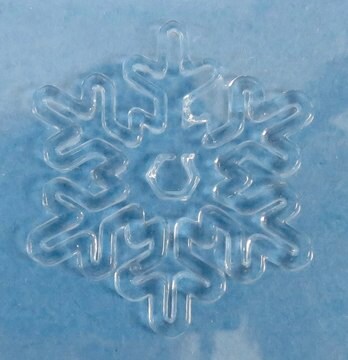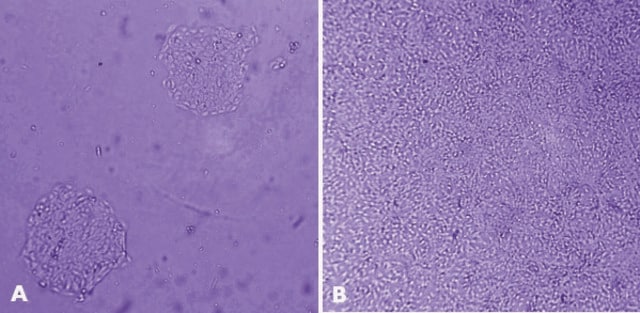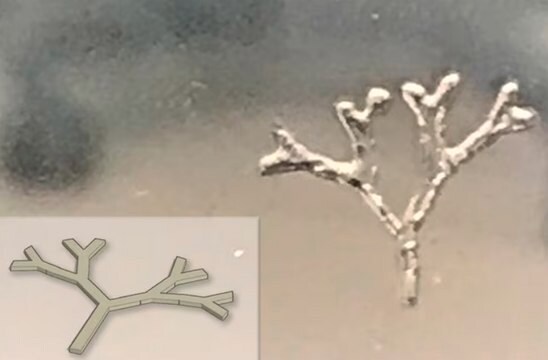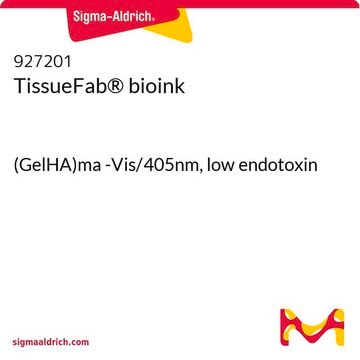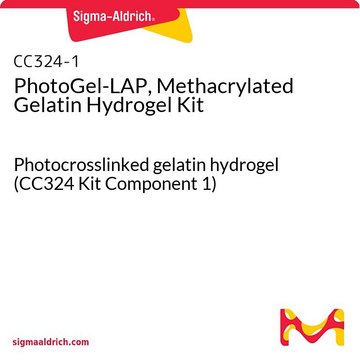934178
TissueFab® bioink
(GelHAHep)MA Vis/405 nm, low endotoxin
동의어(들):
3D Bioprinting, Bioink, Controlled Release, GelMA, Gelatin, Gelatin Methacryloyl, HAMA, Heparin, Heparin Methacrylate, Hyaluronan, Hyaluronic Acid, Hyaluronic Acid Methacrylate, Hydrogel
로그인조직 및 계약 가격 보기
모든 사진(1)
About This Item
UNSPSC 코드:
12352201
NACRES:
NA.28
추천 제품
일반 설명
TissueFab® bioink -(GelHAHep)MA Vis/405 nm, low endotoxin formulation can be used to bioprint cell-laden hydrogels in the desired shape without any supporting material. This bioink can be crosslinked in one step using exposure to 405 nm light for further culture and maturation of cells for tissue engineering and regenerative medicine applications.
애플리케이션
Currently, there is a need for high-quality, commercially available ready-to-use bioink formulations to enable the reproducible fabrication of synthetic tissues and organs by 3D Bioprinting
- drug discovery
- in-vitro disease models
- regenerative medicine-cell-cultured meat
특징 및 장점
- Bioprinting models replicate biology for drug discovery and in vivo applications
- Sterile, low endotoxin-Batch control offers reproducible models for preclinical toxicology testing and drug screening
- Extended shelf-life & stability
기타 정보
Heparin is a naturally occurring linear biopolymer and highly sulfated glycosaminoglycan (GAG). Research has demonstrated that heparin can modulate binding extracellular matrix proteins and sequester growth factors and cytokines, making them useful in 3D applications.
The methacrylate-functionalization of heparin allows thermal or photochemical crosslinking via covalent conjugation. Heparins exhibit high anionic charge densities to promote large swelling ratios in water. Heparin-based bioinks are used in tissue engineering, 3D bio-printing, and drug delivery applications.
Gelatin methacryloyl (GelMA) is a polymerizable hydrogel material derived from natural extracellular matrix (ECM) components. Due to its low cost, abundance, and retention of natural cell binding motifs, gelatin has become a highly sought material for tissue engineering applications. The addition of photocrosslinkable methacrylamide functional groups in GelMA allows the synthesis of biocompatible, biodegradable, and non-immunogenic hydrogels that are stable in biologically relevant conditions and promote cell adhesion, spreading, and proliferation.
Hyaluronic acid (HA) is a linear polysaccharide of alternating D-glucuronic acid/N-acetyl-D-glucosamine found primarily in connective tissues. HA-based hydrogels are prevalent in tissue engineering, 3D bioprinting, and drug delivery applications. The methacrylate (MA) functionalized hyaluronic acid is photo-cross-linkable.
Low Endotoxin, low bioburden: Endotoxins can negatively impact cellular growth, morphology, differentiation, inflammation, and protein expression. The bioburden is the number of contaminated organisms found in a given amount of material.
We test each lot for endotoxins in addition to total bioburden (aerobic and fungal) to minimize unwanted interactions. For more information: Cell Culture FAQs: Bacterial Endotoxin Contamination
The methacrylate-functionalization of heparin allows thermal or photochemical crosslinking via covalent conjugation. Heparins exhibit high anionic charge densities to promote large swelling ratios in water. Heparin-based bioinks are used in tissue engineering, 3D bio-printing, and drug delivery applications.
Gelatin methacryloyl (GelMA) is a polymerizable hydrogel material derived from natural extracellular matrix (ECM) components. Due to its low cost, abundance, and retention of natural cell binding motifs, gelatin has become a highly sought material for tissue engineering applications. The addition of photocrosslinkable methacrylamide functional groups in GelMA allows the synthesis of biocompatible, biodegradable, and non-immunogenic hydrogels that are stable in biologically relevant conditions and promote cell adhesion, spreading, and proliferation.
Hyaluronic acid (HA) is a linear polysaccharide of alternating D-glucuronic acid/N-acetyl-D-glucosamine found primarily in connective tissues. HA-based hydrogels are prevalent in tissue engineering, 3D bioprinting, and drug delivery applications. The methacrylate (MA) functionalized hyaluronic acid is photo-cross-linkable.
Low Endotoxin, low bioburden: Endotoxins can negatively impact cellular growth, morphology, differentiation, inflammation, and protein expression. The bioburden is the number of contaminated organisms found in a given amount of material.
We test each lot for endotoxins in addition to total bioburden (aerobic and fungal) to minimize unwanted interactions. For more information: Cell Culture FAQs: Bacterial Endotoxin Contamination
법적 정보
TISSUEFAB is a registered trademark of Merck KGaA, Darmstadt, Germany
Storage Class Code
12 - Non Combustible Liquids
WGK
WGK 3
Flash Point (°F)
Not applicable
Flash Point (°C)
Not applicable
가장 최신 버전 중 하나를 선택하세요:
자사의 과학자팀은 생명 과학, 재료 과학, 화학 합성, 크로마토그래피, 분석 및 기타 많은 영역을 포함한 모든 과학 분야에 경험이 있습니다..
고객지원팀으로 연락바랍니다.